

Compact Muon Solenoid
LHC, CERN
| CMS-PAS-BPH-16-001 | ||
| Observation of the decay Z→ψℓ+ℓ− in pp collisions at √s= 13 TeV | ||
| CMS Collaboration | ||
| March 2018 | ||
| Abstract: The observation is presented of the Z boson rare decay to a ψ meson and two oppositely charged same-flavor leptons, ℓ+ℓ−, where ψ represents the sum of J/ψ and ψ(2S)→J/ψX, and ℓ=μ, e. The data sample of proton-proton collisions at a center-of-mass energy of √s= 13 TeV corresponds to an integrated luminosity of 35.9 fb−1 accumulated by the CMS experiment at the CERN LHC. The signal is observed with a significance in excess of 5 standard deviations. Removing contributions from ψ(2S) decays to J/ψ, the signal is interpreted as being entirely from Z→J/ψℓ+ℓ−, with its fiducial branching fraction relative to that of the decay Z→μ+μ−μ+μ− measured to be B(Z→J/ψℓ+ℓ−)/B(Z→μ+μ−μ+μ−)= 0.70 ± 0.18 (stat) ± 0.05 (syst). This result is obtained with the assumption of no J/ψ polarization. Extreme polarization scenarios give a variation of the fiducial branching fraction measurement of (− 22 to + 24)%. | ||
|
Links:
CDS record (PDF) ;
inSPIRE record ;
CADI line (restricted) ;
These preliminary results are superseded in this paper, PRL 121 (2018) 141801. The superseded preliminary plots can be found here. |
||
| Figures | |
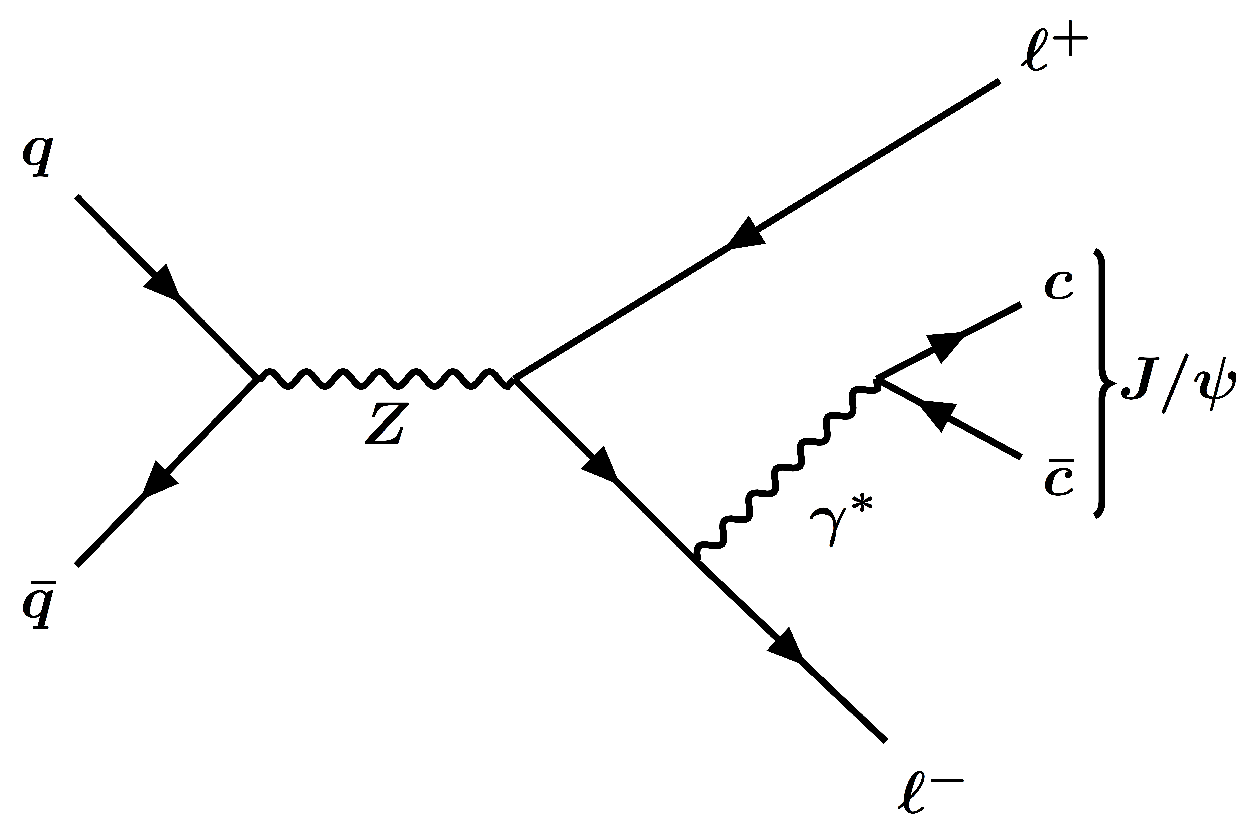
png pdf |
Figure 1:
Leading-order diagram for the Z→J/ψ+ℓ+ℓ− process. |
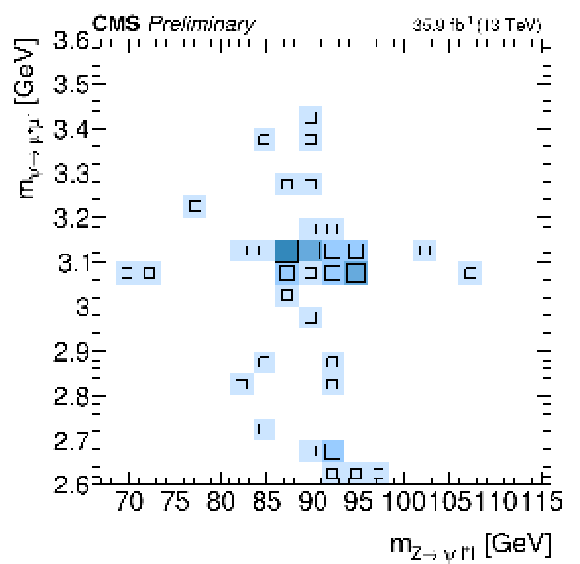
png pdf |
Figure 2:
Distribution of invariant masses mμ+μ− vs. mψ+ℓ+ℓ− for selected candidates. |
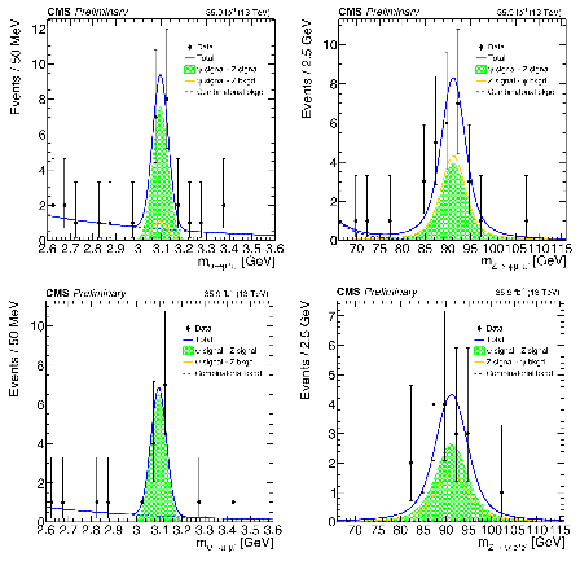
png pdf |
Figure 3:
Invariant mass distributions for the ψ muon pairs (left) and for ψ+ℓ+ℓ− (right), forZ→ψ+μ+μ− (upper) and Z→ψ+e+e− (lower) candidates. In each histogram the data are represented with filled circles, and the solid line curve is the overall fit to the data. The shaded region corresponds to the signal yield, while the dashed lines are the ψ signal from the Z background (left) and the Z signal extracted from the ψ background (right). |
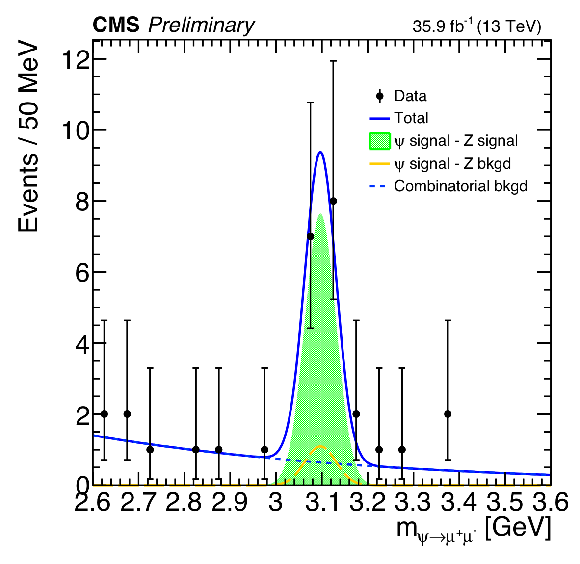
png |
Figure 3-a:
Invariant mass distribution for the ψ muon pairs, for Z→ψ+μ+μ− candidates. The data are represented with filled circles, and the solid line curve is the overall fit to the data. The shaded region corresponds to the signal yield, while the dashed lines are the ψ signal from the Z background. |
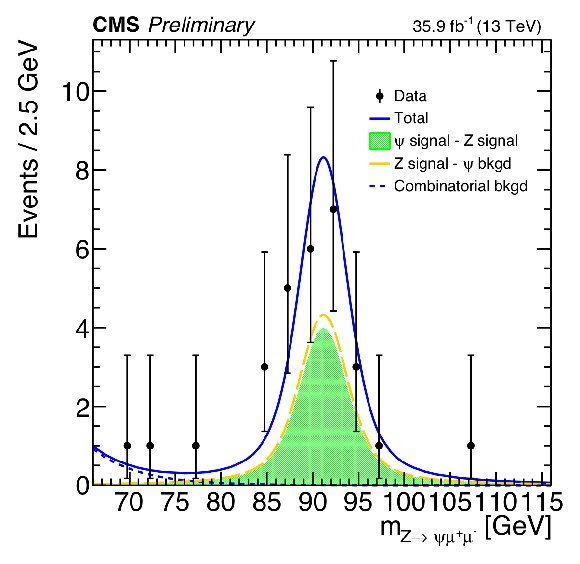
png |
Figure 3-b:
Invariant mass distribution for for ψ+μ+μ−, for Z→ψ+μ+μ− candidates. The data are represented with filled circles, and the solid line curve is the overall fit to the data. The shaded region corresponds to the signal yield, while the dashed lines are the ψ signal from the Z signal extracted from the ψ background. |
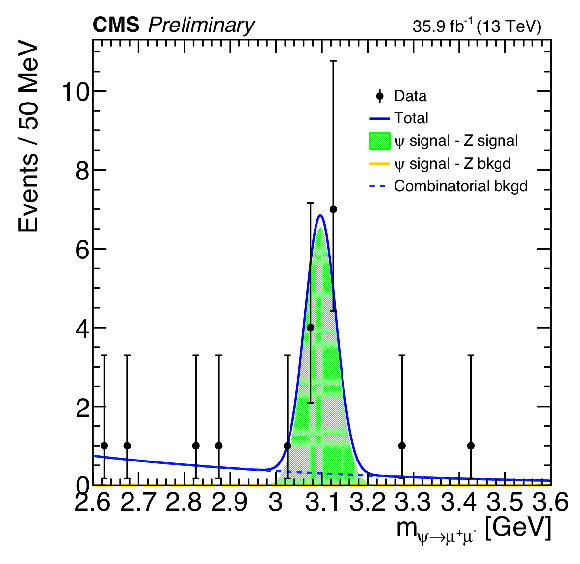
png |
Figure 3-c:
Invariant mass distribution for the ψ muon pairs, for Z→ψ+e+e− candidates. The data are represented with filled circles, and the solid line curve is the overall fit to the data. The shaded region corresponds to the signal yield, while the dashed lines are the ψ signal from the Z background. |
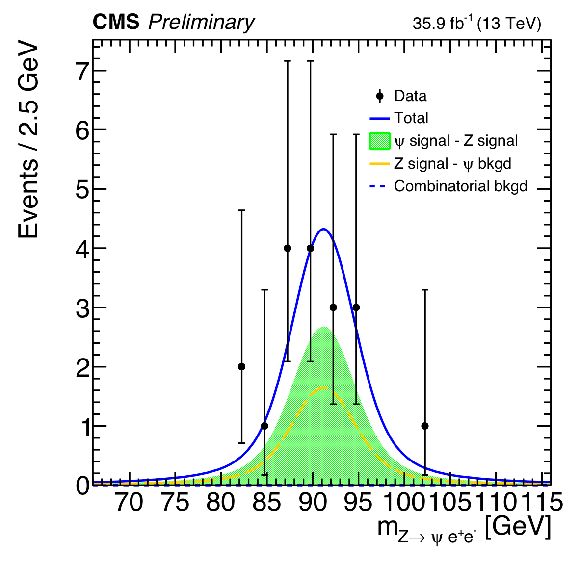
png |
Figure 3-d:
Invariant mass distribution for ψ+e+e−, for Z→ψ+e+e− candidates. The data are represented with filled circles, and the solid line curve is the overall fit to the data. The shaded region corresponds to the signal yield, while the dashed lines are the ψ signal from the Z signal extracted from the ψ background. |
| Tables | |
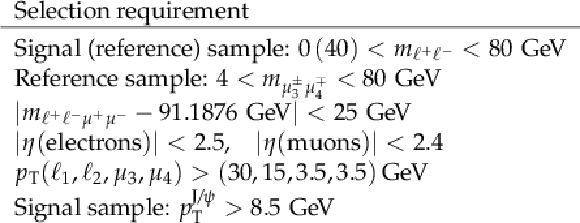
png pdf |
Table 1:
Selection definitions for the branching fraction ratio. Here, ℓ refers to a prompt muon or electron from the signal decay, or to either of the two leading muons from the reference decay. Subscripts give the lepton pT rank in decreasing order. |
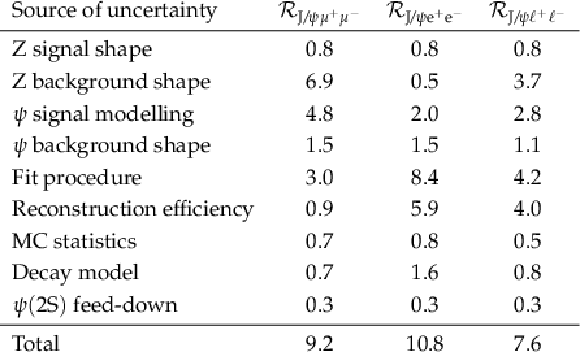
png pdf |
Table 2:
The contributions to the systematic uncertainty in the ratio of the branching fractions for the prompt muon and prompt electron channels, and their sum, in percent. |

png pdf |
Table 3:
Variations in percent of the ratio of branching fractions for different J/ψ polarizations with respect to the value found assuming an unpolarized scenario. |
| Summary |
| In summary, a new decay mode of the Z boson into a ψ meson, where ψ is the sum of J/ψ and ψ(2S)→J/ψX, and an additional pair of leptons (muons or electrons) is observed with a statistical significance greater than 5σ. Using 35.9 fb−1 of pp collisions collected with the CMS detector at √s= 13 TeV, 13.0 ± 3.9 events of the decay Z→ψμ+μ− and 11.2 ± 3.4 events of the decay Z→ψe+e− are observed. This is the first observation of the Z boson decay to a vector meson and two oppositely charged same-flavor leptons. The ratio of the branching fraction for this decay to the branching fraction for the reference channel Z→4μ in the fiducial phase-space of the experiment is RJ/ψℓ+ℓ−= 0.70 ± 0.18 (stat) ± 0.05 (syst). Extreme J/ψ polarization scenarios imply ≈20% variations of this result. These variations can be reduced in the future with larger data samples and improved calculations of the kinematics of the signal process. |
| References | ||||
| 1 | UA1 Collaboration | Experimental observation of lepton pairs of invariant mass around 95GeV/c2 at the CERN SPS collider | PLB126 (1983) 398 | |
| 2 | OPAL Collaboration | A measurement of photon radiation in lepton pair events from Z0 decays | PLB273 (1991) 338 | |
| 3 | CMS Collaboration | Observation of Z decays to four leptons with the CMS detector at the LHC | JHEP 12 (2012) 034 | CMS-SMP-12-009 1210.3844 |
| 4 | CMS Collaboration | Measurement of the ZZ production cross section and Z →ℓ+ℓ−ℓ′+ℓ′− branching fraction in pp collisions at √s= 13 TeV | PLB763 (2016) 280 | CMS-SMP-16-001 1607.08834 |
| 5 | CMS Collaboration | Measurements of the pp→ZZ production cross section and the Z→4ℓ branching fraction, and constraints on anomalous triple gauge couplings at √s= 13 TeV | To be published in \it EPJC | CMS-SMP-16-017 1709.08601 |
| 6 | ATLAS Collaboration | Measurements of four-lepton production at the Z resonance in pp collisions at √s= 7 and 8TeV with ATLAS | PRL 112 (2014) 231806 | 1403.5657 |
| 7 | ATLAS Collaboration | Measurements of four-lepton production in pp collisions at √s= 8 TeV with the ATLAS detector | PLB753 (2016) 552 | 1509.07844 |
| 8 | L. Bergstrom and R. W. Robinett | Z decay into a vector meson and a lepton pair | PLB245 (1990) 249 | |
| 9 | S. Fleming | Electromagnetic production of quarkonium in Z decay | PRD48 (1993) 1914 | hep-ph/9304270 |
| 10 | S. Fleming | J/ψ production from electromagnetic fragmentation in Z decay | PRD50 (1994) 5808 | hep-ph/9403396 |
| 11 | R. Li and J.-X. Wang | The next-to-leading-order QCD correction to inclusive J/ψ(Υ) production in Z decay | PRD82 (2010) 054006 | 1007.2368 |
| 12 | K. C. E. Braaten and T. C. Yuan | Z decay into charmonium via charm quark fragmentation | PRD48 (1993) 4230 | hep-ph/9302307 |
| 13 | P. Ernstrom, L. Lonnblad, and M. Vanttinen | Evolution effects in Z fragmentation into charmonium | Z. Phys. C76 (1997) 515 | hep-ph/9612408 |
| 14 | L. Bergstrom and R. W. Robinett | On the rare decays Z→VV and Z→VP | PRD41 (1990) 3513 | |
| 15 | M. N. Doroshenko, V. G. Kartvelishvili, E. G. Chikovani, and S. M. Esakiya | Vector quarkonium in decays of heavy Higgs particles. (In Russian and in English) | Yad. Fiz. 46 (1987) 864.[Sov. J. NP 46 (1987) 493] | |
| 16 | D.-N. Gao | A note on Higgs decays into Z boson and J/ψ(Υ) | PLB737 (2014) 366 | 1406.7102 |
| 17 | T. Modak and R. Srivastava | Probing anomalous Higgs couplings in H→ZV decays | MPLA32 (2017) 1750004 | 1411.2210 |
| 18 | CMS Collaboration | Performance of CMS muon reconstruction in pp collision events at √s=7TeV | JINST 7 (2012) P10002 | CMS-MUO-10-004 1206.4071 |
| 19 | CMS Collaboration | Performance of electron reconstruction and selection with the CMS detector in proton-proton collisions at √s=8TeV | JINST 10 (2015) P06005 | CMS-EGM-13-001 1502.02701 |
| 20 | CMS Collaboration | The CMS experiment at the CERN LHC | JINST 3 (2008) S08004 | CMS-00-001 |
| 21 | Particle Data Group, C. Patrignani et al. | Review of particle physics | CPC40 (2016) 100001 | |
| 22 | S. Frixione, P. Nason, and C. Oleari | Matching NLO QCD computations with parton shower simulations: the POWHEG method | JHEP 11 (2007) 070 | 0709.2092 |
| 23 | T. Melia, P. Nason, R. Rontsch, and G. Zanderighi | W+W−, WZ and ZZ production in the POWHEG BOX | JHEP 11 (2011) 078 | 1107.5051 |
| 24 | T. Sjostrand, S. Mrenna, and P. Skands | PYTHIA 6.4 physics and manual | JHEP 05 (2006) 026 | hep-ph/0603175 |
| 25 | T. Sjostrand, S. Mrenna, and P. Z. Skands | A brief introduction to PYTHIA 8.1 | CPC 178 (2008) 852 | 0710.3820 |
| 26 | T. Sjostrand et al. | An introduction to PYTHIA 8.2 | CPC 191 (2015) 159 | 1410.3012 |
| 27 | CMS Collaboration | Event generator tunes obtained from underlying event and multiparton scattering measurements | EPJC76 (2016), no. 3, 155 | CMS-GEN-14-001 1512.00815 |
| 28 | NNPDF Collaboration | Parton distributions for the LHC Run II | JHEP 04 (2015) 040 | 1410.8849 |
| 29 | GEANT4 Collaboration | GEANT4---a simulation toolkit | NIMA 506 (2003) 250 | |
| 30 | R. A. Fisher | Combining independent tests of significance | The American Statistician, 2, issue 5 (1948) 30 | |
| 31 | M. J. Oreglia | A study of the reactions ψ′→γγψ | PhD thesis, Stanford University, 1980 SLAC Report SLAC-R-236, see Appendix D | |
| 32 | M. Pivk and F. R. Le Diberder | SPlot: A statistical tool to unfold data distributions | NIMA555 (2005) 356 | physics/0402083 |
| 33 | P. Faccioli, C. Lourenco, J. Seixas, and H. K. Wohri | Towards the experimental clarification of quarkonium polarization | EPJC69 (2010) 657 | 1006.2738 |

|
Compact Muon Solenoid LHC, CERN |

|

|

|

|

|

|